Synergistic Attraction and Ecological Effects of Multi-Source Physical and Chemical Trapping Methods with Different Mechanism Combinations on Rice Pests
Simple Summary
Abstract
1. Introduction
2. Materials and Methods
2.1. Test Tools
2.2. Test Location and Basic Information
2.3. Experimental Design and Methods
2.3.1. Comparison of Light-Shielding Triple-Trap Device and Double-Trap Devices for Trapping Migratory Pests
2.3.2. Three Types Light-Transmitting Trapping Devices Were Used to Compare and Simultaneously Trap Major Pests
2.3.3. Comparison of Trapping Effects of Light-Shielding and Light-Transmitting Triple-Trap Devices for Main Pests in Middle and Late Stages of Rice Production
2.4. Data Analysis
3. Results
3.1. Comparison of the Detection Effects of the Light-Shielding-Type Triple-Trap Device and Double-Trap Device
3.2. Comparison of Detection Effects of the Light-Shielding Triple-Trap Device, the Double-Trap Device, and the Glue-Type Sex Lure Device
3.3. Comparison of the Effects of Light-Transmitting Triple-Trap Device, Double-Trap Device, Light Green Sticky Plate Device, and Glue-Type Sex Lure Device
3.3.1. Application of the sp(Cs)
3.3.2. Application of sp(Cm)
3.4. Comparison of Effects of Light-Shielding and Light-Transmitting Triple-Trap Device
3.4.1. Application of sp(Cm)
3.4.2. Application of sp(Cs)
4. Discussion
4.1. Comparison of Light-Shielding Triple-Trap Device, Double-Trap Device, and Glue-Type Sex Lure Device
4.2. Comparison of the Light-Transmitting Triple-Trap Device, the Double-Trap Device, the Light Green Sticky Plate Device, and the Glue-Type Sex Lure Device
4.3. Comparison of Light-Transmitting and Light-Shielding Trapping of Triple-Trap Device
4.4. Selection of Rice Pest Trapping Devices
5. Conclusions
Author Contributions
Funding
Data Availability Statement
Conflicts of Interest
References
- Tian, L.; Xue, B.; Wang, Z.; Li, D.; Cheng, T. Spectroscopic detection of rice leaf blast infection from asymptomatic to mild stages with integrated machine learning and feature selection. Remote Sens. Environ. 2021, 257, 11235032. [Google Scholar] [CrossRef]
- Becker-Ritt, A.B.; Carlini, C.R. Fungitoxic and insecticidal plant polypeptides. Pept. Sci. 2012, 98, 367–384. [Google Scholar] [CrossRef] [PubMed]
- Ewete, F.K.; Olagbaju, R.A. The development of Aspavia armigera Fabricius (Hemiptera: Pentatomidae) and its status as a pest of cowpea and rice. Int. J. Trop. Insect Sci. 1990, 11, 171–177. [Google Scholar] [CrossRef]
- Martin, J.E.; Jimenez, E.K.B.; Cruz, M.G.; Zhu-Salzman, K.; Way, M.O.; Badillo-Vargas, I.E. Assessing the potential infection of Tagosodes orizicolus (Hemiptera: Delphacidae) by Rice Hoja Blanca virus in Texas. J. Econ. Entomol. 2020, 113, 1018–1022. [Google Scholar] [CrossRef]
- Chen, B.; Chen, Y.; Chen, H.; Liang, Z.; Chen, J.; Wu, R.; Zhang, T.; Zhou, G.; Yang, X. Identification, characterization and prevalence in southern China of a new Iflavirus in the leafhopper Recilia dorsalis (Hemiptera: Cicadellidae). Virus Res. 2023, 323, 199005. [Google Scholar] [CrossRef] [PubMed]
- Jiang, F.; Lu, Y.; Chen, Y.; Cai, D.; Li, G. Image recognition of four rice leaf diseases based on deep learning and support vector machine. Comput. Electron. Agric. 2020, 179, 105824. [Google Scholar] [CrossRef]
- Wang, L.; Ge, S.L.; Zhao, K.H.; Huang, S.W. First Report of Fusarium incarnatum Causing Spikelet Rot on Rice in China. Plant Dis. 2021, 105, 3306. [Google Scholar] [CrossRef]
- Zhuo, F.; Chen, X.; Xia, Y. The Occurrence Characteristics of Rice Diseases and Insect Pests and the Integration of Green Control Technology in China from 2013 to 2022. Chin. J. Biol. Control 2024, 40, 1207–1213. Available online: https://link.cnki.net/doi/10.16409/j.cnki.2095-039x.2023.11.011 (accessed on 22 May 2025).
- Epsky, N.D.; Morrill, W.L.; Mankin, R.W. Traps for Capturing Insects. In Encyclopedia of Entomology; Springer: Dordrecht, The Netherlands, 2008; pp. 3887–3901. [Google Scholar]
- Wang, R.L.; Lu, M.H.; Han, L.Z.; Yu, F.L.; Chen, F.J. Methods and technologies for surveying and sampling the rice planthoppers, Nilaparvata lugens, Sogatella furcifera and Laodelphax striatellus. Chin. J. Appl. Entomol. 2014, 51, 842–847. [Google Scholar]
- Zhang, Y. National Agricultural Technology Extension Service Center. In Manual of Crop Pest Monitoring Technology; China Agriculture Press: Beijing, China, 2006; pp. 130–141. [Google Scholar]
- Zeng, J.; Du, Y.; Jiang, Y. Development and application of sex pheromone in population monitoring of crop insect pests in China. Plant Prot. 2015, 41, 9–15. [Google Scholar] [CrossRef]
- Feng, B.; Guo, Q.; Zhu, F. Ovarian development and synthetic sex pheromone lure trapping of adultsof the rice leaf folder Cnaphalocrocis medinalis (Lepidoptera: Pyralidae). Acta Entomol. Sin. 2017, 60, 211–221. Available online: https://link.cnki.net/doi/10.16380/j.kcxb.2017.02.011 (accessed on 15 March 2024).
- Zhu, F.; Zeng, J.; Tian, Z. Monitoring of population dynamies and development status of rice leaf folder moth by sex pheromone trapping. China Plant Prot. 2018, 38, 43–47. [Google Scholar] [CrossRef]
- Li, K.; Wang, C.; Zhang, C. Monitoring effect of light trap and sex trap on adult Chilo suppressalis. China Plant Prot. 2025, 45, 45–49. [Google Scholar] [CrossRef]
- Zeng, W.; Jiang, C.; Zhang, C. Attractive effects of tender green sticky trap on adults of rice planthoppers. Plant Prot. 2015, 41, 155–159. [Google Scholar] [CrossRef]
- Zeng, W.; Jiang, C.; Chen, Q. Monitoring effect of green sticky insect traps on rice Sogatella furcifera adults. China Plant Prot. 2017, 37, 41–44. [Google Scholar]
- Liu, W.; Liu, Z.; Zhu, X. Development and Application of Insect Sex Pheromone Technology in China. Chin. J. Bio-Log. Control 2022, 38, 803–811. Available online: https://link.cnki.net/doi/10.16409/j.cnki.2095-039x.2022.05.010 (accessed on 6 June 2024).
- Zhang, Y.; Zhang, Z.; Liu, J. Research Progress of Intelligent in Forecasting for Diseases and Insect Pests. Mod. Agrochem. 2023, 22, 9–16. [Google Scholar] [CrossRef]
- Zhang, H.; Zhou, C.; Zhu, X. Preliminary report on the “gathering points into a network” work of intelligent sex-attractant monitoring equipment for major crop pests in Jiangsu Province. China Plant Prot. 2023, 43, 91–94. [Google Scholar] [CrossRef]
- Cao, S.; Zhang, W.; Lin, Q. The Trapping and Monitoring Effects of Different Colored Insect Traps on Pests in Soybean Fields. J. Anhui Agric. Sci. 2024, 52, 157–159, 171. [Google Scholar] [CrossRef]
- Zeng, W.; He, Z. Study on the Trapping Effect and Ecological Impact of Different Color Palettes on the Rice Sogatella furcifera. Biol. Disaster Sci. 2022, 45, 122–130. [Google Scholar] [CrossRef]
- Zeng, W.; Chen, Q.; He, Z. The Monitoring Effects of Trapping Devices Based on Purple Sticky Insect Boards on Adults of Rice Parnara guttata during the Main Damage Period. J. Biol. Disasters 2023, 46, 335–341. [Google Scholar] [CrossRef]
- Zeng, W.; He, Z.; Zhao, Q. Study on the monitoring and prediction effect of the remote pheromone trap monitoring system on Chilo suppressalis. China Plant Prot. 2021, 41, 30–35. [Google Scholar] [CrossRef]
- Wu, J.; Zhang, M.; Feng, C. Evaluation of the monitoring effect of a new intelligent forecasting tool on the Chilo suppressalis. China Plant Prot. 2023, 43, 25–28. [Google Scholar] [CrossRef]
- Zeng, W.; Jiang, C. A Pest Monitoring Device. CN 108522460 B, 19 September 2023. [Google Scholar]
- Zeng, W.; Jiang, C. A Pest Monitoring Device. CN 209251465 U, 16 August 2019. [Google Scholar]
- Zeng, W.; Li, R. Study on the occurrence and evolution of rice planthoppers in Dazhou area over the years. China Plant Prot. 2011, 31, 38–41. [Google Scholar] [CrossRef]
- Zeng, W. Study on the occurrence and control technology of rice leaf roller in Dazhou area. J. Southwest Agric. 2011, 24, 15–19. [Google Scholar]
- Tang, Q. DPS Data Processing System: Experimental Design, Statistical Analysis and Data Mining; Science Press: Beijing, China, 2010; pp. 19–87. [Google Scholar]
- Ye, J.; Luo, H.; Zheng, S. Attractant Effect of Sex Pheromone, Sticky Color Plate and Light Trap on Chilo suppressalis in Rice and Water-oat Fields. J. Anhui Agric. Sci. 2025, 1–5. Available online: https://link.cnki.net/urlid/34.1076.S.20241106.1040.002 (accessed on 22 July 2025).
- Xue, L.; Li, L.; Gao, Y.; Yang, J. Female light capture is shaped by juvenile hormone-mediated post-mating behavior in the diamondback moth. Pest Manag. Sci. 2025. [Google Scholar] [CrossRef]
- Xing, Y.; Sang, H.; Ma, X. Composition of insect community and its effect on two main pests induced by lamps in coastal paddy fields. J. Shihezi Univ. (Nat. Sci.) 2021, 39, 693–696. [Google Scholar] [CrossRef]
- Probst, C.; Gethmann, J.M.; Kampen, H.; Werner, D.; Conraths, F.J. A comparison of four light traps for collecting Culicoides biting midges. Parasitol. Res. 2015, 114, 4717–4724. [Google Scholar] [CrossRef] [PubMed]
- Zhang, J.; Zhang, Y.; Xu, W. Research progress on insect phototaxis and its application in pest control. World Pestic. 2020, 42, 26–35. Available online: https://link.cnki.net/doi/10.16201/j.cnki.cn10-1660/tq.2020.11.04 (accessed on 3 September 2024).
- Shimoda, M.; Honda, K. Insect reactions to light and its applications to pest management. Appl. Entomol. Zool. 1990, 48, 413–421. [Google Scholar] [CrossRef]
- Kim, K.N.; Huang, Q.Y.; Lei, C.L. Advances in insect phototaxis and application to pest management: A review. Pest Manag. Sci. 2019, 75, 3135–3143. [Google Scholar] [CrossRef]
- Shao, Y.; Cheng, J.; Liu, F. Research on phototaxis in Sogatella furcifera and its natural enemy, Cyrtorhinus lividipennis. Chin. J. Appl. Entomol. 2013, 50, 700–705. [Google Scholar] [CrossRef]
- Zeng, W.; Zhang, M.; He, Z. Study on Trapping Efficacy of the Combinations of Sex Pheromone and Different Sticky Colored Cards on Chilo suppressalis Adults. Biol. Disaster Sci. 2021, 44, 418–424. [Google Scholar] [CrossRef]
- Uesugi, R.; Sato, Y. Counting adults on a yellow sticky trap is useful for monitoring the tea spiny whitefly, Aleurocanthus camelliae (Hemiptera, Aleyrodidae), at the early invasion stage. Jpn. J. Appl. Entomol. Zool. 2013, 57, 35–41. [Google Scholar] [CrossRef][Green Version]
- Sinu, P.A.; Mandal, P.; Banerjee, D.; Mallick, S.; Talukdar, T.; Pathak, S.K. Moth pests collected in light traps of tea plantations in North East India: Species composition, seasonality and effect of habitat type. Curr. Sci. 2013, 104, 646–651. Available online: http://www.jstor.org/stable/24089866 (accessed on 25 October 2024).[Green Version]
- Bian, L.; Sun, X.L.; Luo, Z.X.; Zhang, Z.Q.; Chen, Z.M. Design and selection of trap color for capture of the tea leafhopper, Empoasca vitis, by orthogonal optimization. Entomol. Exp. Appl. 2014, 151, 247–258. [Google Scholar] [CrossRef]
- Liu, Y.; Liu, C.; Zhang, J.C.; Zhao, S.Y. Discussion on applicability of the technology of using light to trap in the field of pests and diseases control in tea plantation of China. Key Eng. Mater. 2014, 575, 487–493. [Google Scholar] [CrossRef]
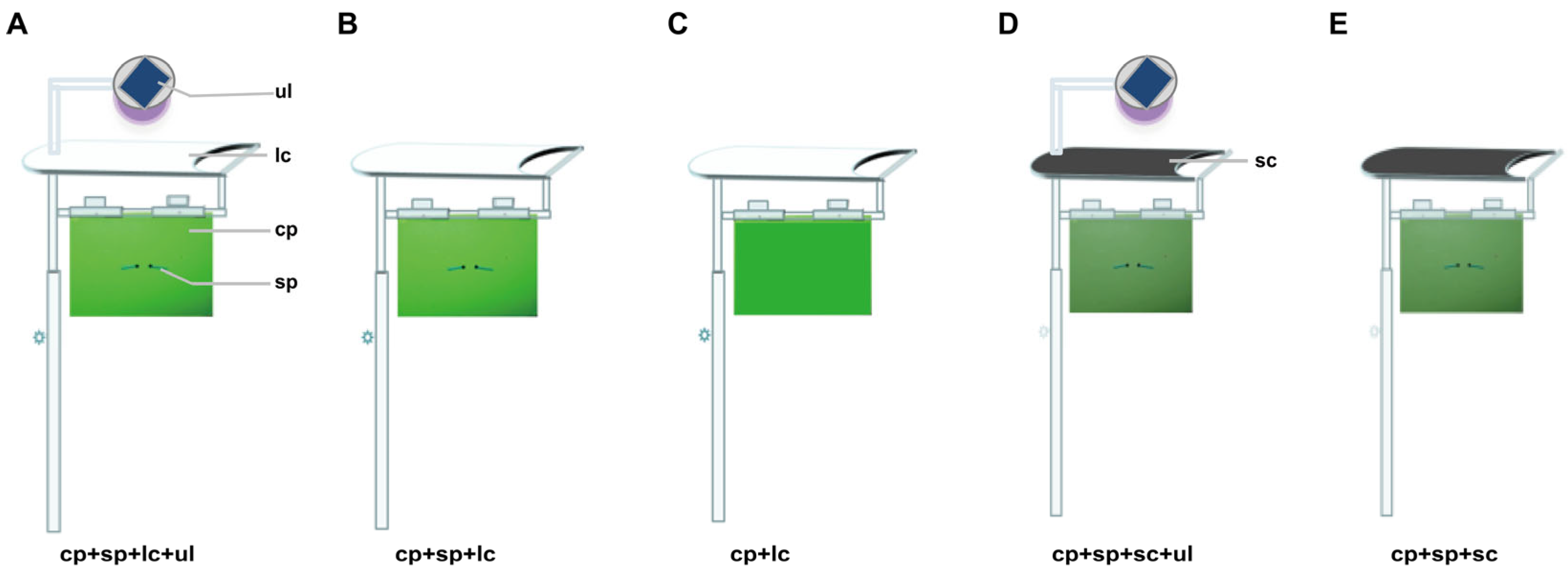





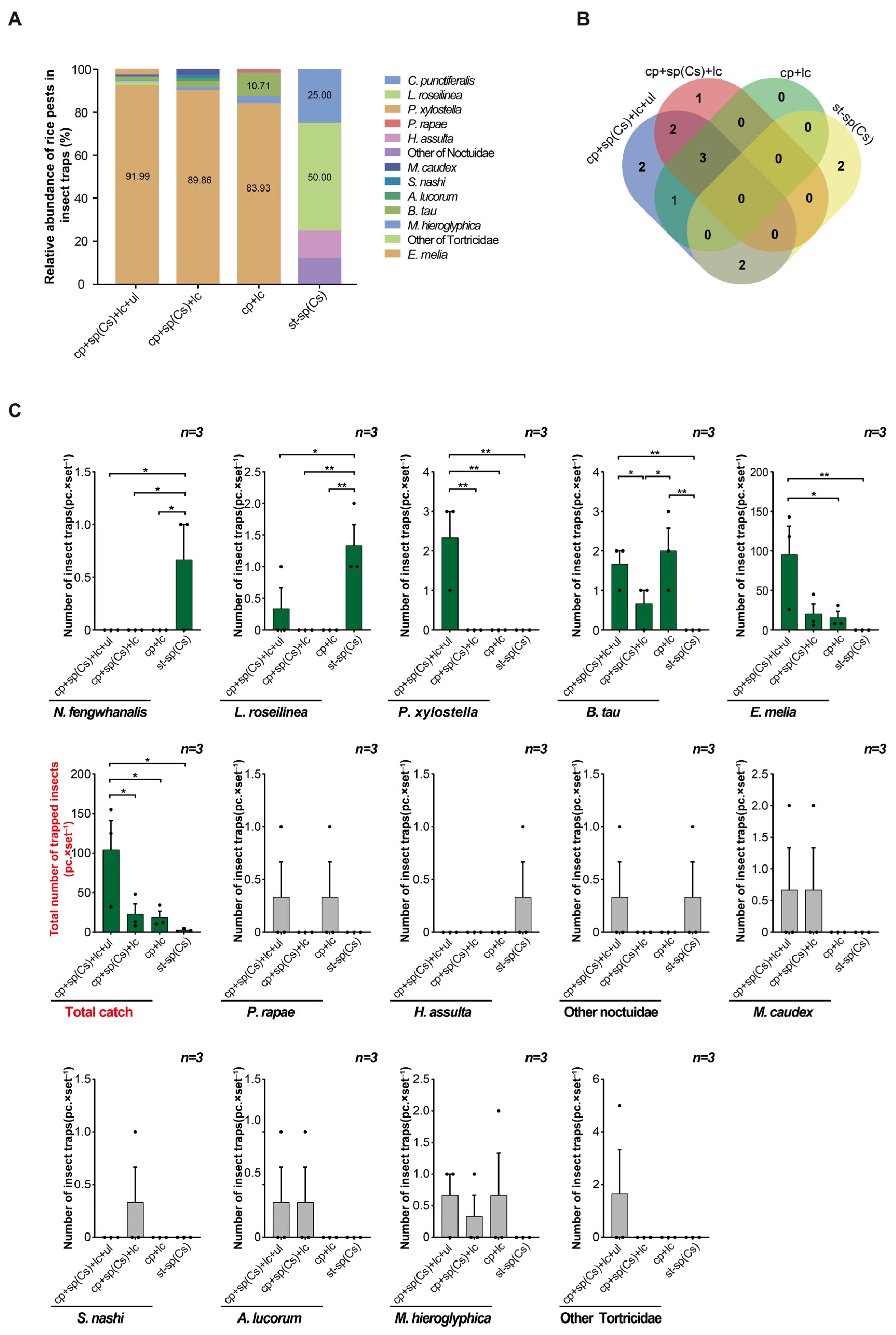
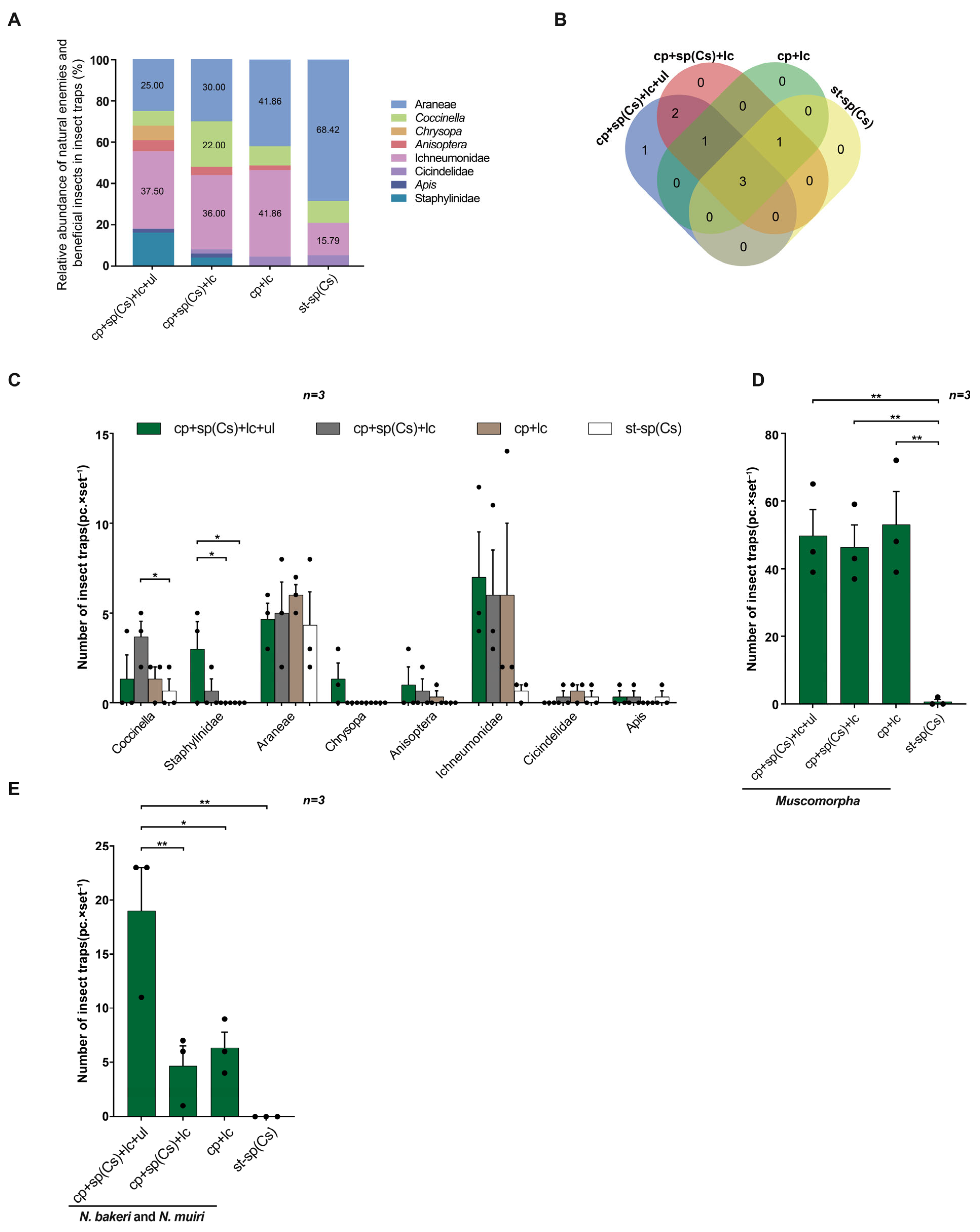
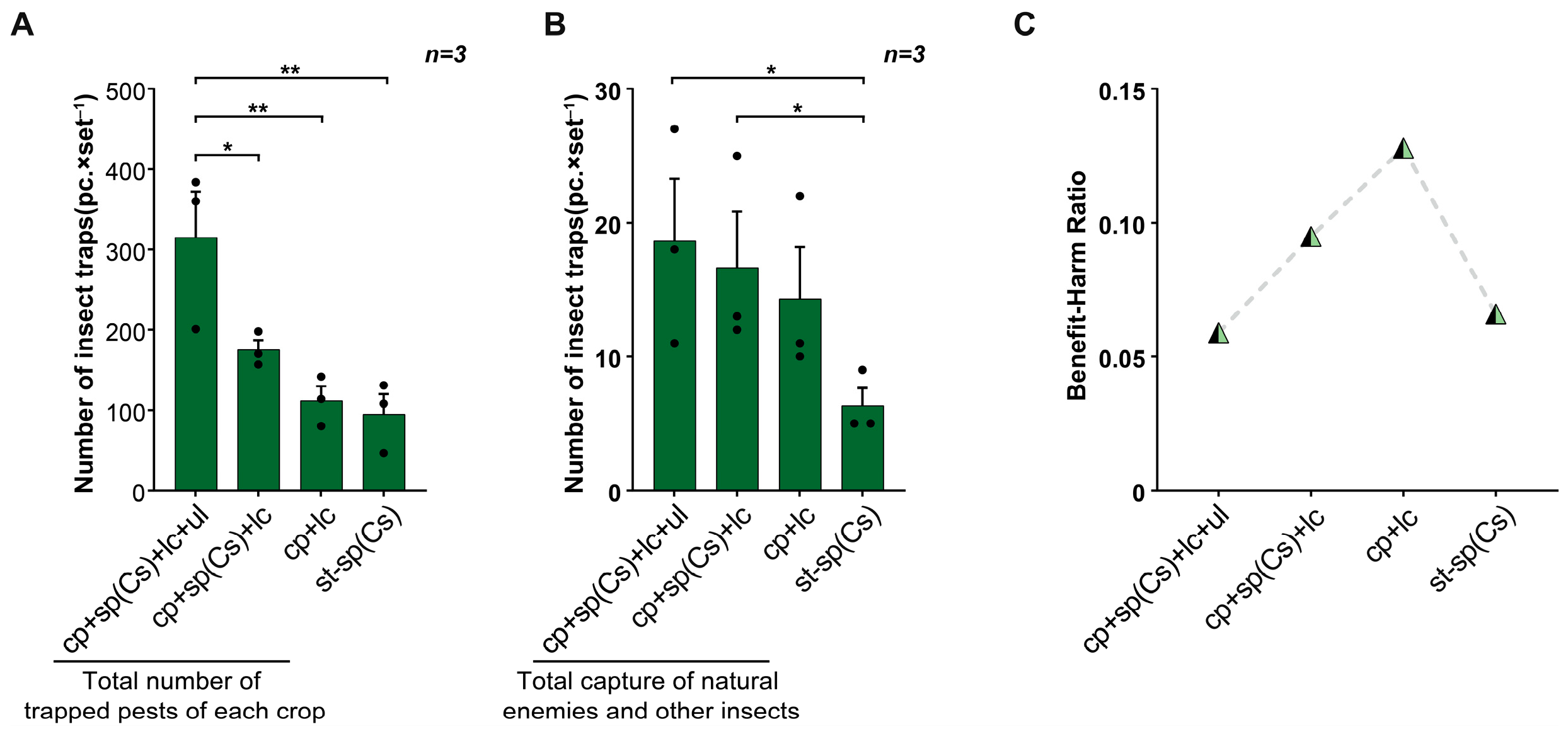

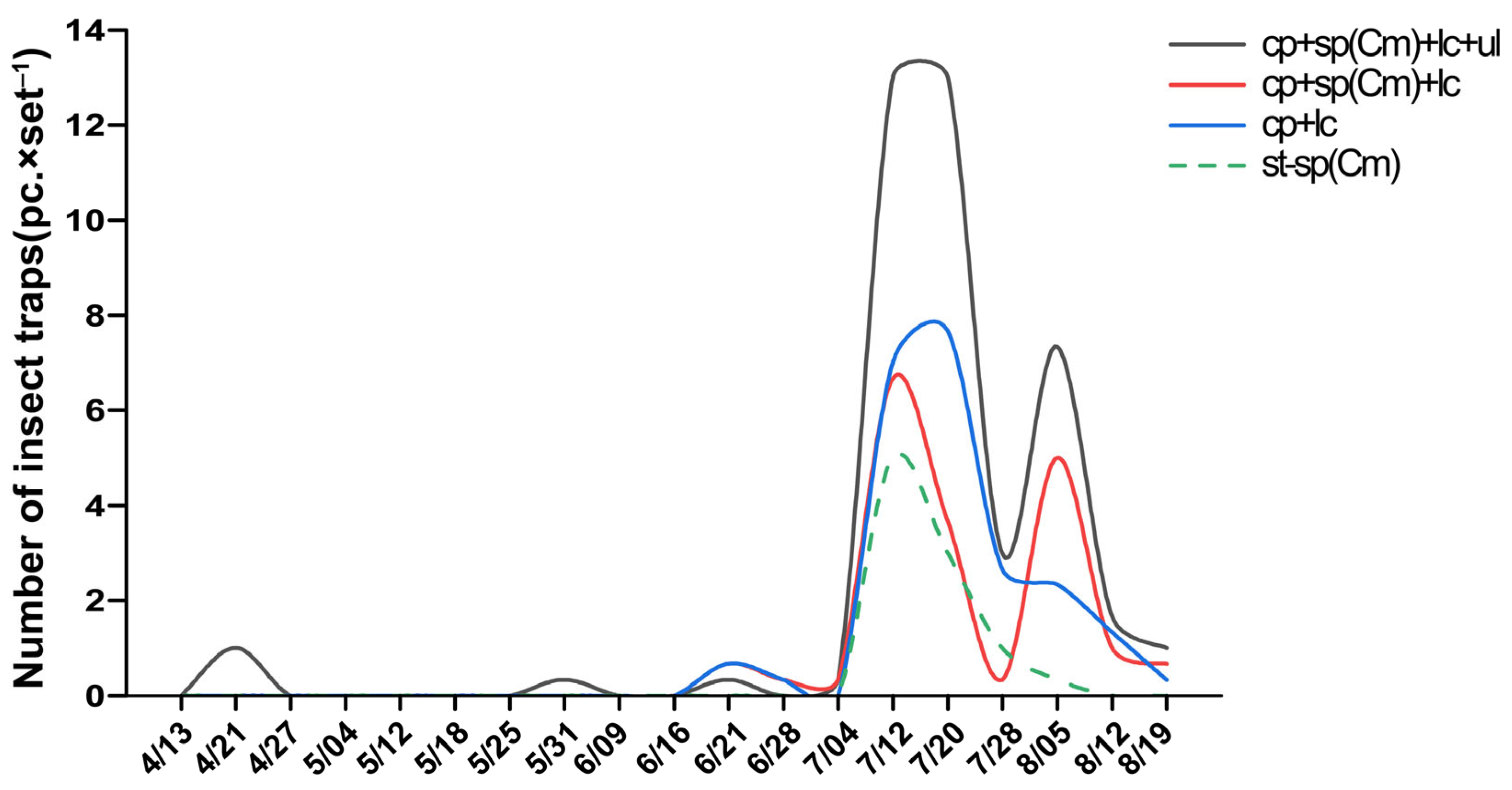
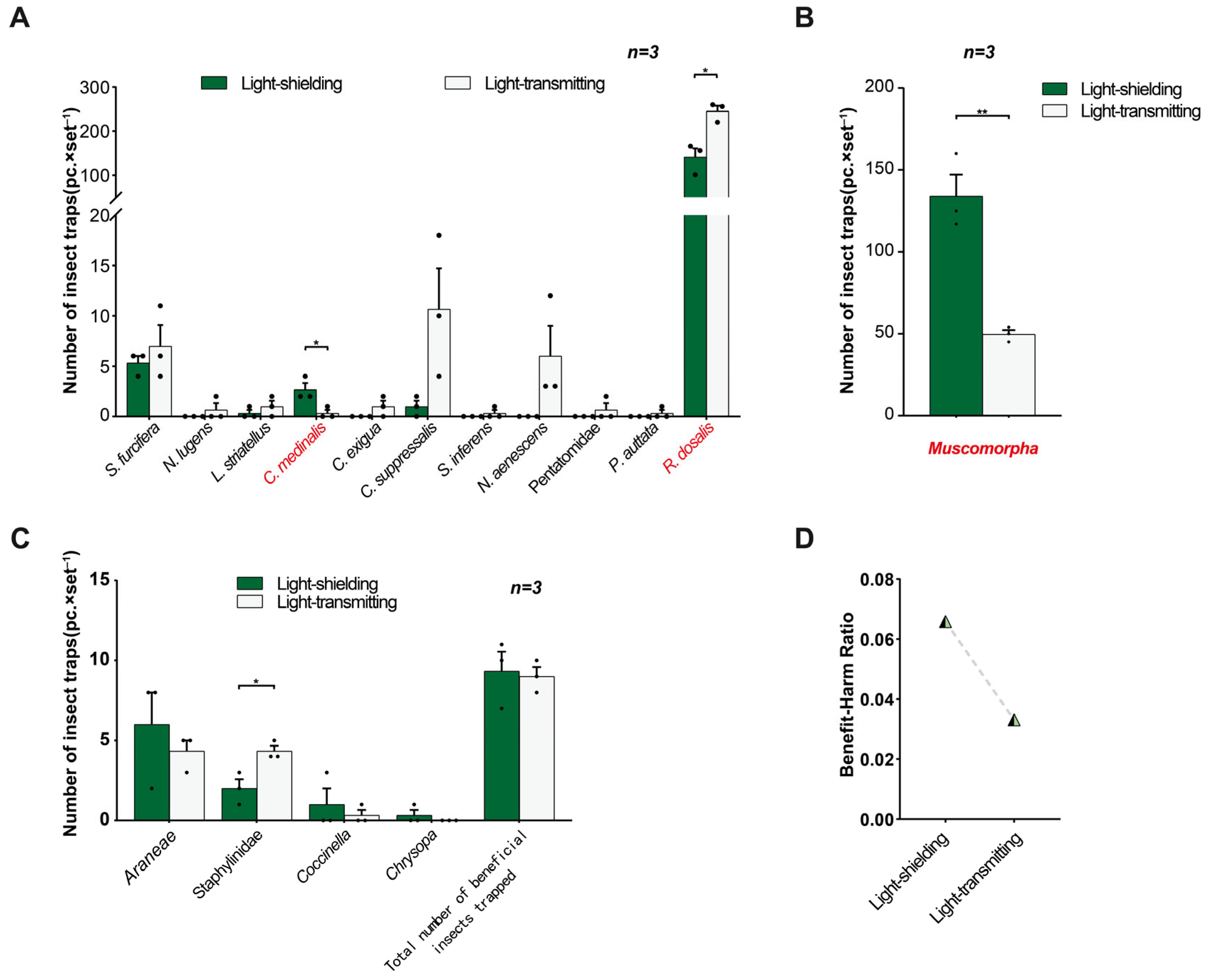





| Field Trial | Year | Test Time | Rice Growing Period | Place | Lure Type | Different Types of Devices for Testing | Simultaneous Comparative Entrapment Survey Main Object |
|---|---|---|---|---|---|---|---|
| No. 1 | 2023 | 13 July–21 August | From the end of booting stage to waxy stage | Test site 1 | C. medinalis (sp(Cm)) |
| Two migration rice pests (C. medinalis and S. furcifera) |
| No. 2 | 1–23 August | Jointing to late booting stage | Test site 2 |
| Major pests in the middle and late stages of rice production, beneficial insects such as natural enemies and major non-target Muscomorpha. | ||
| No. 3 | 2024 | 13 April–9 June | Seedling to jointing stage | Test site 1 | C. suppressalis (sp(Cs)) |
| Overwintering rice pests such as C. suppressalis, other crop pests, beneficial insects such as natural enemy insects, and major non-target Muscomorpha. |
| No. 4 | 9 June–19 August | Jointing to yellow ripening stage | C. medinalis (sp(Cm)) | “Two migration” rice pests and other major pests in the middle and late stages | |||
| No. 5 | 28 July–21 August | Jointing to grouting period | Test site 2 | C. medinalis (sp(Cm)) |
| “Two-migratory” rice pests and other major mid- and late-stage pests, beneficial insects such as natural enemy insects, and major non-target Muscomorpha | |
| No. 6 | 21 August–6 September | From grain filling to yellow maturity stage | C. suppressalis (sp(Cs)) |
Disclaimer/Publisher’s Note: The statements, opinions and data contained in all publications are solely those of the individual author(s) and contributor(s) and not of MDPI and/or the editor(s). MDPI and/or the editor(s) disclaim responsibility for any injury to people or property resulting from any ideas, methods, instructions or products referred to in the content. |
© 2025 by the authors. Licensee MDPI, Basel, Switzerland. This article is an open access article distributed under the terms and conditions of the Creative Commons Attribution (CC BY) license (https://creativecommons.org/licenses/by/4.0/).
Share and Cite
Zeng, W.; Peng, J.; Feng, C.; Chen, Q.; Jiang, C. Synergistic Attraction and Ecological Effects of Multi-Source Physical and Chemical Trapping Methods with Different Mechanism Combinations on Rice Pests. Insects 2025, 16, 1001. https://doi.org/10.3390/insects16101001
Zeng W, Peng J, Feng C, Chen Q, Jiang C. Synergistic Attraction and Ecological Effects of Multi-Source Physical and Chemical Trapping Methods with Different Mechanism Combinations on Rice Pests. Insects. 2025; 16(10):1001. https://doi.org/10.3390/insects16101001
Chicago/Turabian StyleZeng, Wei, Jianping Peng, Chuanhong Feng, Qinghua Chen, and Chunxian Jiang. 2025. "Synergistic Attraction and Ecological Effects of Multi-Source Physical and Chemical Trapping Methods with Different Mechanism Combinations on Rice Pests" Insects 16, no. 10: 1001. https://doi.org/10.3390/insects16101001
APA StyleZeng, W., Peng, J., Feng, C., Chen, Q., & Jiang, C. (2025). Synergistic Attraction and Ecological Effects of Multi-Source Physical and Chemical Trapping Methods with Different Mechanism Combinations on Rice Pests. Insects, 16(10), 1001. https://doi.org/10.3390/insects16101001






